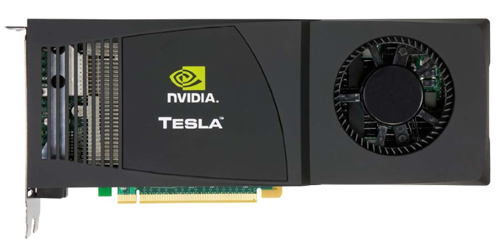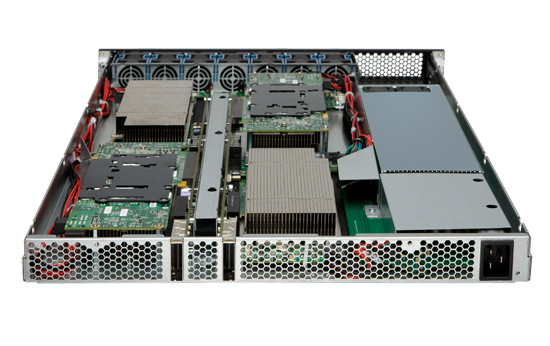NVIDIA's Fermi: Architected for Tesla, 3 Billion Transistors in 2010
by Anand Lal Shimpi on September 30, 2009 12:00 AM EST- Posted in
- GPUs
A Different Sort of Launch
Fermi will support DirectX 11 and NVIDIA believes it'll be faster than the Radeon HD 5870 in 3D games. With 3 billion transistors, it had better be. But that's the extent of what NVIDIA is willing to talk about with regards to Fermi as a gaming GPU. Sorry folks, today's launch is targeted entirely at Tesla.

A GeForce GTX 280 with 4GB of memory is the foundation for the Tesla C1060 cards
Tesla is NVIDIA's High Performance Computing (HPC) business. NVIDIA takes its consumer GPUs, equips them with a ton of memory, and sells them in personal or datacenter supercomputers called Tesla supercomputers or computing clusters. If you have an application that can run well on a GPU, the upside is tremendous.

Four of those C1060 cards in a 1U chassis make the Tesla S1070. PCIe connects the S1070 to the host server.
NVIDIA loves to cite examples of where algorithms ported to GPUs work so much better than CPUs. One such example is a seismic processing application that HESS found ran very well on NVIDIA GPUs. It migrated a cluster of 2000 servers to 32 Tesla S1070s, bringing total costs down from $8M to $400K, and total power from 1200kW down to 45kW.
| HESS Seismic Processing Example | Tesla | CPU |
| Performance | 1 | 1 |
| # of Machines | 32 Tesla S1070s | 2000 x86 servers |
| Total Cost | ~$400K | ~$8M |
| Total Power | 45kW | 1200kW |
Obviously this doesn't include the servers needed to drive the Teslas, but presumably that's not a significant cost. Either way the potential is there, it's just a matter of how many similar applications exist in the world.
According to NVIDIA, there are many more cases like this in the market. The table below shows what NVIDIA believes is the total available market in the next 18 months for these various HPC segments:
| Processor | Seismic | Supercomputing | Universities | Defence | Finance |
| GPU TAM | $300M | $200M | $150M | $250M | $230M |
These figures were calculated by looking at the algorithms used in each segment, the number of Hess-like Tesla installations that can be done, and the current budget for non-GPU based computing in those markets. If NVIDIA met its goals here, the Tesla business could be bigger than the GeForce one. There's just one problem:
As you'll soon see, many of the architectural features of Fermi are targeted specifically for Tesla markets. The same could be said about GT200, albeit to a lesser degree. Yet Tesla accounted for less than 1.3% of NVIDIA's total revenue last quarter.
Given these numbers it looks like NVIDIA is building GPUs for a world that doesn't exist. NVIDIA doesn't agree.
The Evolution of GPU Computing
When matched with the right algorithms and programming efforts, GPU computing can provide some real speedups. Much of Fermi's architecture is designed to improve performance in these HPC and other GPU compute applications.
Ever since G80, NVIDIA has been on this path to bring GPU computing to reality. I rarely get the opportunity to get a non-marketing answer out of NVIDIA, but in talking to Jonah Alben (VP of GPU Engineering) I had an unusually frank discussion.
From the outside, G80 looks to be a GPU architected for compute. Internally, NVIDIA viewed it as an opportunistic way to enable more general purpose computing on its GPUs. The transition to a unified shader architecture gave NVIDIA the chance to, relatively easily, turn G80 into more than just a GPU. NVIDIA viewed GPU computing as a future strength for the company, so G80 led a dual life. Awesome graphics chip by day, the foundation for CUDA by night.
Remember that G80 was hashed out back in 2002 - 2003. NVIDIA had some ideas of where it wanted to take GPU computing, but it wasn't until G80 hit that customers started providing feedback that ultimately shaped the way GT200 and Fermi turned out.
One key example was support for double precision floating point. The feature wasn't added until GT200 and even then, it was only added based on computing customer feedback from G80. Fermi kicks double precision performance up another notch as it now executes FP64 ops at half of its FP32 rate (more on this later).
While G80 and GT200 were still primarily graphics chips, NVIDIA views Fermi as a processor that makes compute just as serious as graphics. NVIDIA believes it's on a different course, at least for the short term, than AMD. And you'll see this in many of the architectural features of Fermi.










415 Comments
View All Comments
Pirks - Monday, October 5, 2009 - link
No, Jarred, they are advancing towards 2560x1600 on every PC gamer's desk. Since they move towards that (used to be 800x600 everywhere, now it's more like 1280x1024 everywhere, in couple of years it'll be 1680x1050 everywhere and so on) they cannot be described as stagnant, hence your statement is BS, Jarred.mejobloggs - Tuesday, October 6, 2009 - link
I think I'll agree with Jared on this oneLCD tech isn't advancing enough to get decent high quality large screens at a decent price. 22" seems about the sweet spot which is usually 1680x1050
Pirks - Wednesday, October 7, 2009 - link
This sweet spot used to be 19" 1280x1024 a while ago, with 17" 1024x768 before that. In a couple of years sweet spot will move to 24" 1920x1200, and so on. Hence monitor resolution does progress, it does NOT stagnate, and you do listen to Jarred's fairy tales too much :PJarredWalton - Friday, October 9, 2009 - link
What we have here is a failure to communicate. My point, which you are ignoring, is that maximum resolutions are "stagnating" in the sense that they are remaining static. It's not "BS" or a "fairy tale", unless you can provide detail that shows otherwise. I purchased a 24" LCD with a native 1920x1200 resolution six years ago, and then got a 30" 2560x1600 LCD two years later. Outside of ultra-expensive solutions, nothing is higher than 2560x1600 right now, is it?1280x1024 was mainstream from about 7-11 years ago, and 1024x768 hasn't been the norm since around 1995 (unless you bought a crappy 14/15" LCD). We have not had a serious move to anything higher than 1920x1080 in the mainstream for a while now, but even then 1080p (or 1200p really) has been available for well over 15 years if you count the non-widescreen 1600x1200. I was running 1600x1200 back in 1995 on my 75 pound 21" CRT, for instance, and I know people that were using it in the early 90s. 2048x1536 and 2560x1600 are basically the next bump up from 1600x1200 and 1920x1200, and that's where we've stopped.
Now, Anand seems to want even higher resolutions; personally, I'd be happier if we first found a way to make those resolutions work well for every application (i.e. DPI that extends to everything, not just text). Vista was supposed to make that a lot better than XP, but really it's still a crap shoot. Some apps work well if you set your DPI to 120 instead of the default 96; others don't change at all.
Pirks - Friday, October 9, 2009 - link
I agree that maximum resolution has stagnated at 2560x1600, my point was that the average resolution of PC gamers is still moving from pretty low 1280x1024 towards this holy grail of 2560x1600 and who knows how many years will pass until every PC gamer will have such "stagnated" resolution on his/her desk.So yeah, max resolution stagnated, but average resolution did not and will not.
I am as mad as hell - Friday, October 2, 2009 - link
Hi everyone,first off, I am not mad as hell! I just registered this acct after being an Anandtech reader for 10+ years. That's right. It's also my #1 tech website. I read several others, but this WAS always my favorite.
I don't know what happened here lately, but it's becoming more and more of a circus in here.
I am going to make a few points suggestions:
1) In the old days reviews were reviews, this days I there are a lot more PRE-views and picture shows and blog (chit chatting) entries.
2) In the old days a bunch of hardware was rounded up and compared to each other (mobos, memory, PSU's, etc..) I don't see that here much anymore. It's kind of worthless to me just to review one PSU or one motherboard at the time. Round em all up and then lets have a good ole fashioned shootout.
3) I miss the monthly buyer guides. What happened to them? I like to see CPU + Mobo + Mem + PSU combo recommendations in the MOST BANG FOR THE BUCKS categories (Something most people can afford to buy/build)
4) Time to moderate the comments section, but not censorship. My concern is not with f-words, but with trolls and comment abusers. I can't stand it. I remember the old days when then a famous site totally self-destruct, and at that time I think had maybe more readers than Anand, (hint: It had the English version of "Tiburon" as name as part of the domain name) when their forum went totally out of control because it was moderated.
5) Also, time to upgrade the comments software here at Anandtech. It needs a up/down ratings feature that even many newspaper websites offer these days.
shotage - Saturday, October 3, 2009 - link
I agree with the idea of a comments rating system (thumbs up or down). Its a democratic way of moderating. It also saves the need for those short replies when all you want to convey is that you agree or not.Maybe also an abuse button that people can click on should things get really out of control..?
Skiprudder - Friday, October 2, 2009 - link
The up/down idea is perfect for the site. Now why didn't I think of that! =)AnnonymousCoward - Friday, October 2, 2009 - link
I don't like commenter ratings, since they give unequal representation/visibility of comments, they affect your perception of a message before you read it, and it's one more thing to look at while skimming comments.Skiprudder - Friday, October 2, 2009 - link
I'm sorry, but I'm going to ask for a ban of SiliconDoc as well. One person has single-handedly taken over the reply section to this article. I was actually interested in reading what other folks thought of what I feel is a rather remarkable new direction that nvidia is taking in terms of gpu design and marketing, and instead there are literally 30 pages of a single person waging a shouting matching with the world.Right now there isn't free speech in this discussion because an individual is shouting everyone down. If the admins don't act, people are likely to stop using the reply section all together.